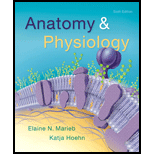
When the semilunar valves are open, which of the following are occurring? (a) 2, 3, 5, 6, (b) 1, 2, 3, 7, (c) 1, 3, 5, 6, (d) 2, 4, 5, 7.
_____(1) coronary arteries fill
_____(2) AV valves are closed
_____(3) ventricles are in systole
_____(4) ventricles are in diastole
_____(5) blood enters aorta
_____(6) blood enters pulmonary arteries
_____(7) atria contract
To determine:
The correct occurrence of sequences if semilunar valves are open
(a) 2, 3, 5, 6, (b) 1, 2, 3, 7, (c) 1, 3, 5, 6, (d) 2, 4, 5, 7
____ (1) coronary arteries fill
____ (2) AV valves are closed
____ (3) ventricles are in systole
____ (4) ventricles are in diastole
____ (5) blood enters aorta
____ (6) blood enters pulmonary arteries
____ (7) atria contract
Answer to Problem 1MC
Solution:
(a) 2, 3, 5, 6: The events that occur when the semilunar valves are open are listed as follows:
1. The closing of atrioventricular valves.
2. The ventricles are in the systolic stage.
3. The blood enters the aorta.
4. The blood enters the pulmonary arteries.
Explanation of Solution
The semilunar valve is situated between the left ventricle and aorta of the heart. The opening of the semilunar valves marks the systolic stage. The atrioventricular valves at this stage are closed in order to prevent the backflow of the blood. The blood is pumped to the aorta and the pulmonary artery to distribute it to the different parts of the body.
Want to see more full solutions like this?
Chapter 17 Solutions
Anatomy & Physiology (6th Edition)
- Molecular Biology Question Please help. Thank you Explain what is meant by the term “defective virus.” Explain how a defective virus is able to replicate.arrow_forwardMolecular Biology Explain why changing the codon GGG to GGA should not be harmful. Please help . Thank youarrow_forwardStage Percent Time in Hours Interphase .60 14.4 Prophase .20 4.8 Metaphase .10 2.4 Anaphase .06 1.44 Telophase .03 .72 Cytukinesis .01 .24 Can you summarize the results in the chart and explain which phases are faster and why the slower ones are slow?arrow_forward
- Can you circle a cell in the different stages of mitosis? 1.prophase 2.metaphase 3.anaphase 4.telophase 5.cytokinesisarrow_forwardWhich microbe does not live part of its lifecycle outside humans? A. Toxoplasma gondii B. Cytomegalovirus C. Francisella tularensis D. Plasmodium falciparum explain your answer thoroughly.arrow_forwardSelect all of the following that the ablation (knockout) or ectopoic expression (gain of function) of Hox can contribute to. Another set of wings in the fruit fly, duplication of fingernails, ectopic ears in mice, excess feathers in duck/quail chimeras, and homeosis of segment 2 to jaw in Hox2a mutantsarrow_forward
- Select all of the following that changes in the MC1R gene can lead to: Changes in spots/stripes in lizards, changes in coat coloration in mice, ectopic ear formation in Siberian hamsters, and red hair in humansarrow_forwardPleiotropic genes are genes that (blank) Cause a swapping of organs/structures, are the result of duplicated sets of chromosomes, never produce protein products, and have more than one purpose/functionarrow_forwardA loss of function mutation in Pitx1 enhancers can cause (blank) Removal of Pitx1 exons and growth of ectopic hindlimbs, growth of extra ectopic forelimbs, loss of forelimb specification and development, and loss of hindlimb specification and developmentarrow_forward
- Hox1a most likely contributes to (blank) patterning in the developing embryo? Ventral, posterior, limb or anteriorarrow_forwardSelect all of the following that can help establish Hox gene expression boundaries (things that affect Hox and not things that Hox affects). Retinoic acid, anterior/posterior axis, fibroblast growth factors, vagal neural crest, and enhancersarrow_forwardEctopic expression of Hox often results in (blank) phenotypes. (Blank) transformations are characterized by the replacement of one body part/structure with another. Hoxeotic, homealoneotic, joexotic, or homeoticarrow_forward
 Human Physiology: From Cells to Systems (MindTap ...BiologyISBN:9781285866932Author:Lauralee SherwoodPublisher:Cengage Learning
Human Physiology: From Cells to Systems (MindTap ...BiologyISBN:9781285866932Author:Lauralee SherwoodPublisher:Cengage Learning Fundamentals of Sectional Anatomy: An Imaging App...BiologyISBN:9781133960867Author:Denise L. LazoPublisher:Cengage Learning
Fundamentals of Sectional Anatomy: An Imaging App...BiologyISBN:9781133960867Author:Denise L. LazoPublisher:Cengage Learning Human Biology (MindTap Course List)BiologyISBN:9781305112100Author:Cecie Starr, Beverly McMillanPublisher:Cengage Learning
Human Biology (MindTap Course List)BiologyISBN:9781305112100Author:Cecie Starr, Beverly McMillanPublisher:Cengage Learning





